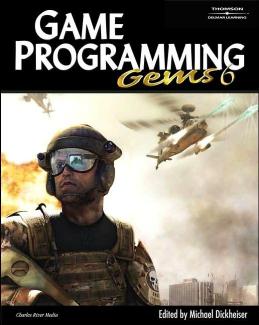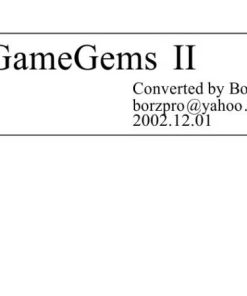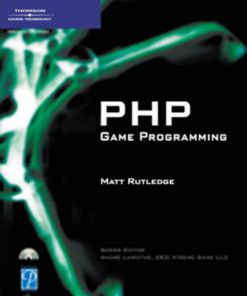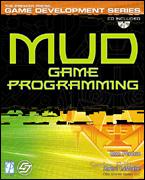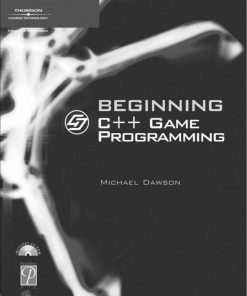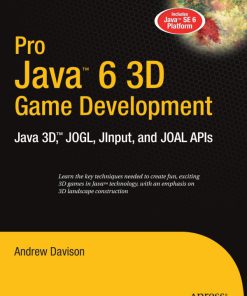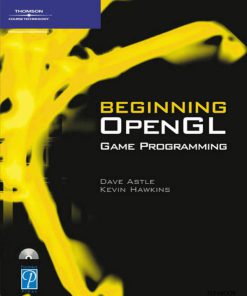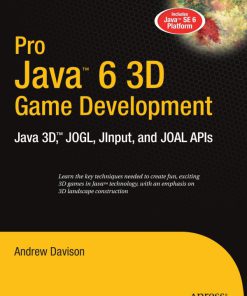Game Programming Gems 6 1st edition by Mike Dickheiser 1584504501 9781584504504
$50.00 Original price was: $50.00.$25.00Current price is: $25.00.
Authors:Mike (Mike Dickheiser) Dickheiser , Series:Gaming [73] , Author sort:Dickheiser, Mike , Languages:Languages:eng , Published:Published:Apr 2007 , Publisher:Charles River Media
Game Programming Gems 6 1st edition by Mike Dickheiser – Ebook PDF Instant Download/Delivery.1584504501,9781584504504
Full download Game Programming Gems 6 1st edition after payment
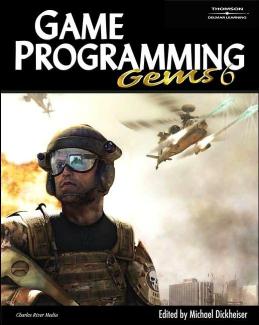
Product details:
ISBN 10:1584504501
ISBN 13:9781584504504
Author:Mike Dickheiser
Welcome to the sixth volume of the Game Programming Gems series. With team sizes constantly expanding, developers are finding themselves pushed to become increasingly specialized. This makes it important to have cutting-edge, ready-to-use material in your specialization, as well as resources that you can call upon if you need to work outside your area of expertise. Volume 6 has been explicitly designed with your current challenges in mind. With the new generation of machines, players expect higher-fidelity models and animations, fancier physics and graphics effects, and more intelligent AI. All of these capabilities require robust teams and longer schedules, so to help ensure that your games are still delivered on time and on budget, you�ll find 50 all new articles written by experts in game technology from many different backgrounds and over twenty countries. This volume also includes a brand new section dedicated to Scripting and Data-Driven Systems, which is focused entirely on the growing trend of removing the programmer from the data-tweaking loop. So, whether you’re a new game programmer starting out on this exciting path, a grizzled, industry veteran, or a most welcome visitor, we hope that you will find inspiration, insight, and at least one or two true gems to use in your world!
Game Programming Gems 6 1st Table of contents:
SECTION 1 GENERAL PROGRAMMING
Introduction
Adam Lake, IntelCorporation
1.1 Lock-Free Algorithms
Toby Jones, Microsoft
1.2 Utilizing Multi-Core Processors with OpenMP
Pete Isensee
1.3 Computer Vision in Games Using the OpenCV Library
Arnau Ramisa, Enric Marti, and Enric Vergara
1.4 Geographic Grid Registration of Game Objects
Roger Smith
1.5 BSP Techniques
Octavian Marius Chincisan
1.6 Closest-String Matching Algorithm
James Boer, ArenaNet
1.7 Using CPPUnit to Implement Unit Testing
Blake Madden
1.8 Fingerprinting Prerelease Builds to Deter and Detect Piracy
Steve Rabin, Nintendo of America, Inc.
1.9 Faster File Loading with Access Based File Reordering
David L. Koenig, Touchdown Entertainment, Inc.
1.10 Stay in the Game: Asset Hotloading for Fast Iteration
Noel Llopis and Charles Nicholson, High Moon Studios
SECTION 2 MATHEMATICS AND PHYSICS
Introduction
Jim Van Verth, Red Storm Entertainment
2.1 Floating-Point Tricks
Chris Lomont, Cybernet Systems Corporation
2.2 GPU Computation in Projective Space using Homogeneous Coordinates
Vaclav Skala, University of West Bohemia
2.3 Solving Systems of Linear Equations Using the Cross Product
Anders Hast, Creative Media Lab, University of Gävle
2.4 Efficient Sequence Indexing
Palem Gopalakrishna, Indian Institute of Technology, Bombay, India
2.5 Exact Buoyancy for Polyhedra
Erin Catto, Crystal Dynamics
2.6 Real-Time Particle-Based Fluid Simulation with Rigid Body Interaction
Takashi Amada, Sony Computer Entertainment, Inc.
SECTION 3 ARTIFICIAL INTELLIGENCE
Introduction
Brian Schwab, Sony Computer Entertainment of America
3.1 Applying Model-Based Decision-Making Methods to Games
Dr. Armand Prieditis
3.2 Achieving Coordination With Autonomous NPCs
Diego Garcés, FX Interactive
3.3 Behavior-Based Robotic Architectures for Games
Hugo Pinto and Luis Otavio Alvares
3.4 Constructing a Goal-Oriented Robot for Unreal Tournament Using Fuzzy Sensors, Finite-State Machines and Behavior Networks
Hugo Pinto and Luis Otavio Alvares
3.5 A Goal-Oriented Unreal Bot: Building a Game Agent with Goal-Oriented Behavior and Simple Personality using Extended Behavior Networks
Hugo Pinto and Luis Otavio Alvares
3.6 Short-term Memory Modelling using a Support Vector Machine
Julien Hamaide
3.7 Using the Quantified Judgment Model for Engagement Analysis
Michael Ramsey
3.8 Designing a Multi-Layer Pluggable AI Engine
Sébastien Schertenleib, Swiss Federal Institute of Technology, Virtual Reality Lab
3.9 A Fuzzy Control Approach to Managing Scene Complexity
Gabriyel Wong
SECTION 4 SCRIPTING AND DATA-DRIVEN SYSTEMS
Introduction
Graham Rhodes, Applied Research Associates, Inc.
4.1 Scripting Language Survey
Diego Garcés, FX Interactive
4.2 Binding C/C++ Objects to Lua
Waldemar Celes, PUC-Rio, Luiz Henrique de Figueiredo, Institute for Pure and Applied Mathematics, and Roberto Ierusalimschy, PUC-Rio
4.3 Programming Advanced Control Mechanisms with Lua Coroutines
Waldemar Celes, PUC-Rio, Luiz Henrique de Figueiredo, Institute for Pure and Applied Mathematics, and Roberto Ierusalimschy, PUC-Rio
4.4 Managing High-Level Script Execution within Multithreaded Environments
Sébastien Schertenleib, Swiss Federal Institute of Technology, Virtual Reality Lab
4.5 Exposing Actor Properties Using Non-Intrusive Proxies
Matthew Campbell and Curtis Murphy, BMH Associates, Inc.
4.6 Game Object Component System
Chris Stoy, Red Storm Entertainment
SECTION 5 GRAPHICS
Introduction
Paul Rowan
5.1 Automatic Realistic Idle Motion Synthesis for Interactive Characters
Arjan Egges, Thomas Di Giacomo, and Nadia Magnenat-Thalmann, MIRALab ¿ University of Geneva
5.2 Spatial Partitioning Using an Adaptive Binary Tree
Martin Fleisz
5.3 Enhanced Object Culling with (Almost) Oriented Bounding Boxes
Ben St. John, Siemens Corporate Technology
5.4 Skin Splitting for Optimal Skin Rendering
Dominic Filion
5.5 GPU Terrain Rendering
Harald Vistnes
5.6 Interactive Fluid Dynamics and Rendering on the GPU
Frank Luna
5.7 Fast Per-Pixel Lighting with Many Lights
Frank Puig Placeres, University of Informatic Sciences, Cuba
5.8 Rendering Road Signs Sharply
Jorn Loviscach, Hochschule Bremen (University of Applied Sciences)
5.9 Practical Sky Rendering for Games
Aurelio Reis, Raven Software
5.10 High Dynamic Range Rendering using OpenGL Frame Buffer Objects
Allen Sherrod, Ultimate Game Programming
SECTION 6 AUDIO
Introduction
Alexander Brandon, Midway Home Entertainment
6.1 Real-Time Sound Generation From Deformable Meshes
Marq Singer, Red Storm Entertainment
6.2 A Lightweight Generator for Real-Time Sound Effects
Frank Luchs
6.3 Real-Time Mixing Busses
James Boer, ArenaNet
6.4 Potentially Audible Sets
Dominic Filion
6.5 A Cheap Doppler Effect
Julien Hamaide
6.6 Faking Real-Time DSP Effects
Robert Sparks, Radical Entertainment
SECTION 7 NETWORK AND MULTIPLAYER
Introduction
Scott Jacobs, Virtual Heroes
7.1 Dynamically Adaptive Streaming of 3D Data for Animated Characters
Thomas Di Giacomo, HyungSeok Kim, Stephane Garchery, Nadia Magnenat-Thalmann,
MIRALab, C.U.I. ¿ University of Geneva, and Chris Joslin, School of Information Technology, Carleton University
7.2 Complex Systems Based High-Level Architecture for Massively Multiplayer Games
Viknashvaran Narayanasamy, Kok-Wai Wong, and Chun Che Fung, Murdoch University
7.3 Generating Globally Unique Identifiers for Game Objects
Yongha Kim, Nexon Corporation
7.4 Massively Multiplayer Online Prototype (MMOP): Utilizing Second Life for Game Concept Prototyping
Peter A. Smith, NavAir
7.5 Reliable Peer-to-Peer Gaming Connections Penetrating NAT
Larry Shi and Ying Sha
About the CD-ROM
People also search for Game Programming Gems 6 1st :
game programming gems series
game programming gems 5 pdf
game coding classesc
game programming
game programming patterns amazon
You may also like…
eBook CHM
Beginning C++ Game Programming 1st Edition by Michael Dawson ISBN 1592002056 9781592002054
eBook PDF
Beginning C++ Game Programming 1st edition Edition by Michael Dawson ISBN 1592002056 9781592002054
eBook PDF
Beginning OpenGL Game Programming 1st edition by Dave Astle,Kevin Hawkins 1592003699 9781592003693

